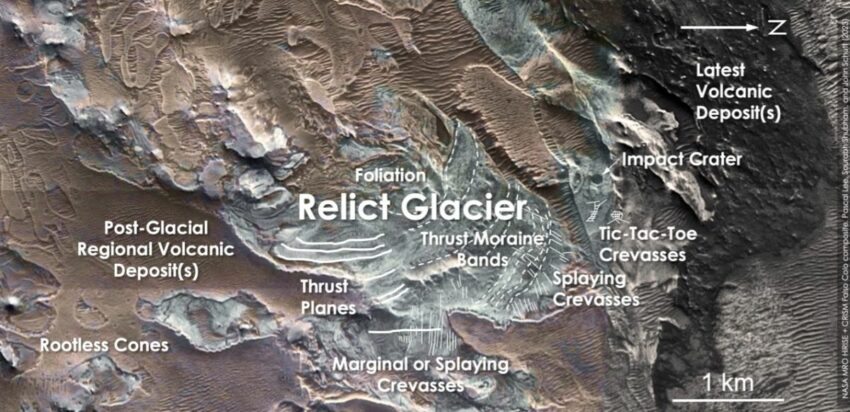This finding might have substantial ramifications for future human exploration on Mars.
Around the equator of Mars, remnants of a contemporary glacier have been discovered, showing that ice may still persist at shallow depths. Such a discovery, if verified, might have enormous ramifications for future human exploration on Mars.

Scientists find evidence of a’modern’ glacier on Mars, indicating the existence of buried water ice.
Using data from NASA’s Mars Reconnaissance Orbiter (MROHigh )’s Resolution Imaging Science Experiment (HiRISE), researchers from the SETI Institute and the Mars Institute identified light-toned deposits (LTDs) on the Martian surface. This light-colored sulfate salts, crevasse fields, and moraine bands are characteristic of a “relict glacier.”
This glacier is located near the equator of Mars at 7° 33′ S, 93° 14′ W, and is believed to be 3.7 miles (6 kilometers) long, up to 2.5 miles (4 kilometers) broad, and up to 1.1 miles (1.7 kilometers) in height, according to a statement from the SETI Institute.
In the release, Pascal Lee, main author of the study and planetary scientist at the SETI and Mars Institutes, stated, “What we’ve discovered is not ice, but a salt deposit with the exact morphological traits of a glacier.” We believe that salt developed on top of a glacier while crevasse fields and moraine bands on the ice below were preserved.
The occurrence of such a glacier shows that Mars may have had water ice on its surface more recently than previously believed, which has consequences for our understanding of the planet’s habitability and for future research missions.
This Mars area has a history of volcanism. Sourabh Shubham, a graduate student in the Department of Geology at the University of Maryland and co-author of the study, said in a statement that chemical reactions would have occurred at the boundary between volcanic materials and glacier ice to form a layer of sulfate salts that had hardened over time. This is the most plausible explanation for the presence of hydrated and hydroxylated sulfates in this light-colored deposit.

